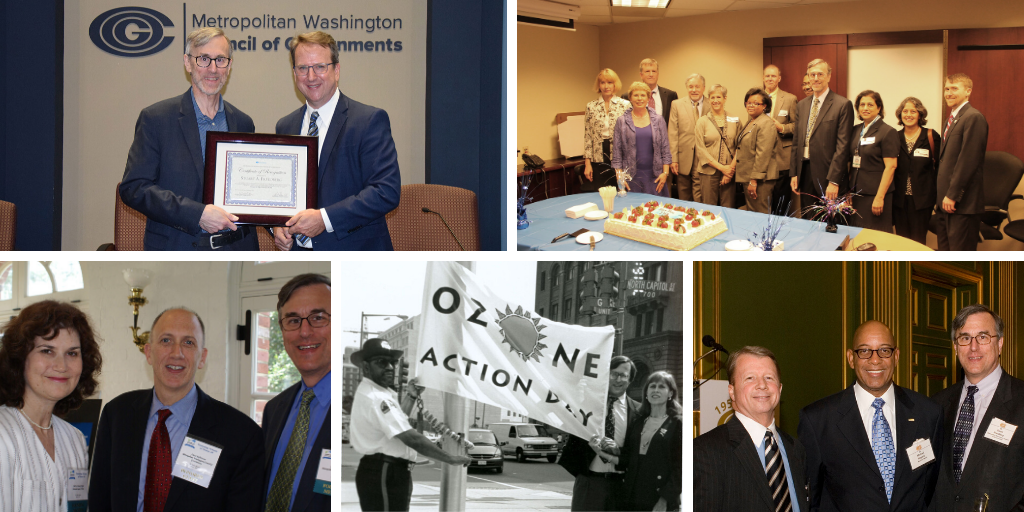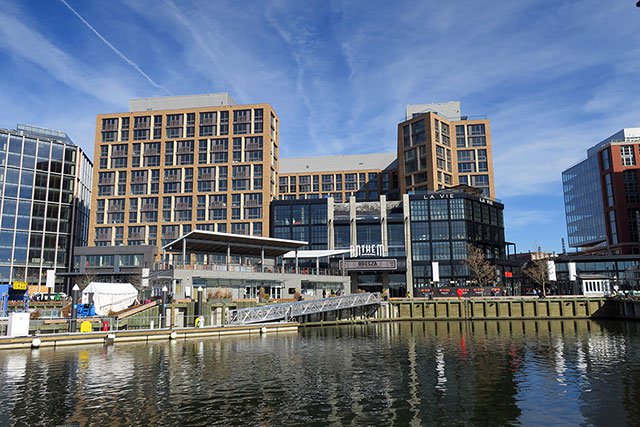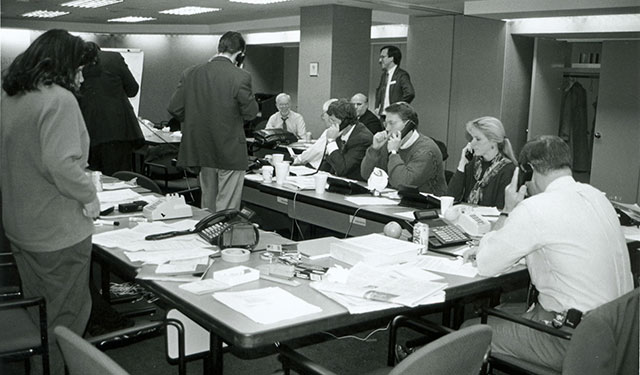Stuart Freudberg began working at the Metropolitan Washington Council of Governments (COG) in February 1980. He was 26 at the time; COG was 22. Freudberg had earned his master’s degree in civil engineering from MIT and was looking forward to his new job doing Potomac River water quality modeling. He imagined he would stay for about three years.
At that time, the region was home to 3.2 million people. Metro had recently opened a few segments of its rail system and was a symbol of regional pride and progress. There were also several serious challenges requiring closer collaboration among area governments. The Potomac and Anacostia Rivers had very poor water quality. Air quality was often unhealthy, too. Smog regularly blanketed the region during the summer months.
COG was a different organization then. Its work, primarily driven by federal grants, was not always aligned with the needs or goals of its members governments. But that was starting to change around the time that Freudberg arrived, and throughout his career, he supported COG’s evolution into a go-to organization for its members. He did this through his work supporting all five of COG’s executive directors as well as members and stakeholders and providing leadership in several of COG’s most meaningful efforts, such as the restoration of the Potomac River, emergency preparedness activities following 9/11, and Metro funding and safety initiatives.
In 1986, Executive Director Walter Scheiber named Freudberg, then 33, the Director of COG’s Department of Environment Programs. Over time, Freudberg expanded the department and its programs, managing 30 planners, scientists, and engineers in various environmental fields, including water quality monitoring and modeling, wastewater and stormwater management, air quality planning and forecasting, solid waste management, airport noise, energy conservation, and more. Freudberg was later promoted by Executive Director Chuck Bean to become Senior Director of Environment, Homeland Security, and Health in 2013 and Deputy Executive Director in 2014, adding oversight of information technology and finance and accounting.
Now, 40 years to the day he started at COG, Freudberg is retiring and leaving behind a legacy of partnerships, programs, and plans to help the region work together on major challenges for decades to come. This news highlight looks at a few big themes and moments from his career.

From top left, clockwise: Stuart Freudberg with Chuck Bean at retirement event, 2012 Blue Plains Agreement celebration, with Robert Dix and Michael Rogers at COG 50th anniversary, with Ruth Crone promoting an ozone action day, and with Sherry Conway Appel and David Robertson at a Clean Air Partners anniversary.
Tackling big problems, regionally
When Freudberg began at COG, the new environmental engineer was coming in “against the tide” while the organization was experiencing a major contraction. Due to federal funding cutbacks, its staff shrunk from more than two hundred employees to just eighty by the mid-1980s.
He joined the new environmental department of a dozen staff members and went to work supporting the regional effort to restore the Potomac River. The river was more than a major ecological concern. Its poor health also threatened the future growth of the region. Some jurisdictions had sewer moratoriums in place limiting construction, and the U.S. Environmental Protection Agency had warned it would continue to impose a region-wide moratorium if area leaders did not create a new agreement to expand the District of Columbia’s Blue Plains wastewater treatment plant to meet the demands of the growing region while simultaneously meeting strict water quality standards.
In 1983, an algal bloom turned a 20-mile stretch of the Potomac bright green and brought additional attention to the river’s health. Freudberg helped staff an expert panel convened by COG to determine the bloom’s cause. It was during this time that he had the opportunity to begin briefing COG’s Chief Administrative Officers Committee (CAOs) and learned how to “translate technical content into English” for decision-makers.
In the Potomac River restoration, Freudberg participated in a process that was a model for much of COG’s work going forward—producing sound scientific data, building an understanding of the issues and solutions, and helping area leaders forge political consensus.
The work by Freudberg and COG’s environmental staff in the water quality modeling and wastewater management fields, helped guide the river’s remarkable turnaround. Subsequent controls on phosphorus and nitrogen led to major improvements. The Blue Plains agreement of 1985 expanded the sewage treatment plant, allowing Maryland and Virginia jurisdictions to share the cost, use the facility, and continue to grow. COG's support of this partnership continues to the present day as illustrated by the subsequent 2012 Blue Plains agreement.
Today, the Potomac and Anacostia rivers attract area residents and spur economic development along their banks as evidenced by the Wharf, Capitol Riverfront, Alexandria Waterfront, and National Harbor.

The Wharf (Daniel Lobo/Flickr)
Responding to regional emergencies and new priorities
How did an environmental engineer have homeland security added to his portfolio?
Freudberg points out his training and experience overlapped with homeland security in many ways. There is a technical foundation to the work in both fields including with air and water quality models that can be used to analyze threats to public safety. There is an overlapping focus on protecting critical infrastructure, like water and wastewater treatment plants and electric power plants. And planning for and responding to emergencies is a significant responsibility.
For example, in December 1993, water from the Dalecarlia Treatment Plant contained sediment, which led the EPA to declare it unsafe to drink, affecting the supply for several million people. Freudberg oversaw COG’s response, including a 24/7 call center which fielded 15,000 calls from concerned residents about the boil water orders.

COG Drinking Water Hotline
Following the September 11, 2001 attack on the Pentagon, COG stepped up to support its members in an “all hands on deck” effort. In the months and years that followed (to this day), COG has helped local officials prepare for future emergencies. In addition to developing the water-related elements of COG’s regional emergency plan, Freudberg was tasked with improving communications among CAOs and other area officials and co-created an emergency messaging system, the Regional Incident Communication and Coordination System (RICCS).
Through these emergencies and coordination at COG, Freudberg says officials have come to value their partnership and build closer connections. The Homeland Security Executive Committee integrates local state and federal officials as part of the same decision-making body, something that previous groups lacked. Collaboration among area utilities has also made great strides.
When a smoke incident in 2015 led to the death of a passenger on Metro, COG was asked by officials on the region’s Congressional delegation to conduct a review of the transit system’s communication systems. In addition to the communications review, officials asked COG to help on two other major initiatives---supporting the states to create a new independent Washington Metrorail Safety Commission (WMSC) and identifying the system’s capital needs. Freudberg was part of the team that facilitated the WMSC, and he worked closely with the CAOs and elected officials on COG’s Metro Strategy Group, which helped lay the groundwork for the landmark dedicated funding agreement in 2018.
Building lasting partnerships
Freudberg says his career at COG has been all about relationships. His familiarity with elected officials, CAOs, local government staff, and stakeholders allowed him to jump into very different projects.
So, it’s no surprise that Freudberg is proudest of the many partnerships, programs, and plans that he has helped develop with COG staff and members, including water supply and drought planning, the Anacostia restoration partnership.
In air quality, he led the creation of the Metropolitan Washington Air Quality Committee, the group that prepares air quality plans for the region. In addition, with his counterparts in Baltimore and the states, Freudberg helped launch a public outreach program now known as Clean Air Partners, which educates area residents on ways they can improve air quality through voluntary actions. Through the combined work of governments, businesses, and individuals, the region’s air has improved dramatically with eight times fewer unhealthy air days than just 20 years ago.
Through COG’s Chesapeake Bay Policy Committee, local governments established a strong voice in the Bay restoration efforts, which was critical since the region accounts for more than 25 percent of the Bay watershed population and shoulders much of the cleanup costs. Freudberg worked closely with the CBPC’s first chair, Fairfax County Supervisor Penelope Gross, and subsequent chairs to help shape Bay agreements, track implications to local governments, and address a range of water resource issues, leading to the group being rebranded as the Chesapeake Bay and Water Resources Policy Committee.
In the mid-2000s, when area officials identified climate change as a top priority, Freudberg and staff worked with them to draft the National Capital Region Climate Change Report, which proposed ambitious greenhouse gas emissions reduction goals. To advance the goals, Freudberg worked with officials to help them establish COG’s Climate, Energy, and Environment Policy Committee, which has since overseen climate and energy action plans and measured progress. The region’s climate work has been recognized, most recently in 2019 by the Global Covenant of Mayors for Climate and Energy.
Freudberg says he expects current and future staff will bring new ideas, and use and adapt these programs and partnerships, to help COG and its members tackle the challenges of the next several decades.
“At COG, there’s always something new and different on the horizon. You have a chance to shape and support work that will have a long-lasting impact in our region," Freudberg said. "COG is about regionalism, collaboration, and ultimately an intense commitment to making a difference in people’s lives now and for future generations. I am very lucky to have been part of this organization for 40 years. I’m confident it will continue to thrive and to quote our founding executive director, Walter Scheiber, 'the best for COG is yet to come.’”
MORE: COG 50th Anniversary history book